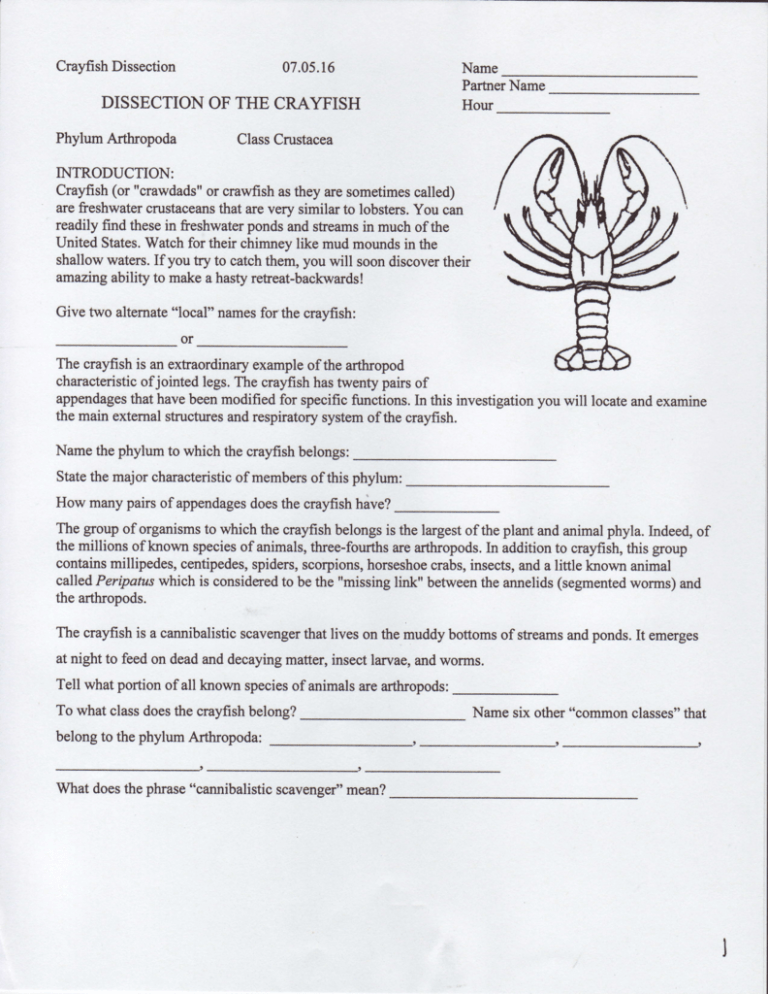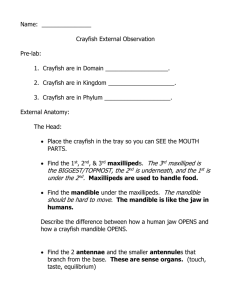Crayfish Dissection
advertisement

CrayFrsh
Dissection
0 7 .0 5.16
DISSECTIONOF THE CRAYFISH
PhylumArthropoda
Name
PartnerName
Hour
ClassCrustacea
INTRODUCTION:
Crayfish(or "crawdads"or crawfishasthey aresometimescalled)
arefreshwatercrustaceans
that arevery similarto lobsters.You can
readilyfind thesein freshwaterpondsandstreamsin muchof the
United States.Watchfor their chimneylike mud moundsin the
shallowwaters.If you try to catchthem,you will soondiscovertheir
amazingability to makea hastyretreat-backwards!
Give two altemate"local" namesfor the cravfish:
The crayfishis an extraordinaryexampleof the arthropod
characteristic
ofjointed legs.The crayfishhastwentypairsof
appendages
that havebeenmodifiedfor specificfunctions.In this investigationyou will locateandexamine
the main externalstructuresandrespiratorysystemof the crayfish.
Namethephylumto which the crayfishbelongs:
Statethe majorcharacteristic
of membersof this phylum:
How manypairsof appendages
doesthe crayfishhive?
The groupof organismsto which the crayfishbelongsis the largestof theplant andanimalphyla.Indeed,of
the millions of known speciesof animals,three-fourthsarearthropods.In additionto crayfish,this group
containsmillipedes,centipedes,
spiders,scorpions,horseshoe
crabs,insects,anda little known animal
calledPeripatuswhich is considered
to be the "missinglink" betweenthe annelids(segmented
worms)and
the arthropods.
The crayfishis a cannibalisticscavenger
that lives on the muddybottomsof streamsandponds.It emerges
at night to feedon deadanddecayingmatter,insectlarvae,andworms.
Tell whatportionof all knownspeciesof animalsarearthropods:
To what class doesthe crayfish belong?
belongto the phylumArthropoda:
What doesthephrase"cannibalisticscavenger"mean?
Name six other "common classes"that
Hereis a sunmaryof the phylumArthropoda.Useyour pencilto circlethe subphylum(mostbiologistscall
it a class)to whichthecrayfishbelongs.....
5u
ffi
h0ft6sndc cf'tib6
centipede
rrniltipede
rnot all hsect
ordor rhown
&cnocquitoet
As an arthropod,the crayfishhasa body protectedby a hardexoskeleton
madeof chitin.Periodicallv,the
crayfishsheds,or molts,its outerskeletonandgrowsa new one.After molting,the crayfishtakesin large
amountsof waterto increaseits body sizebeforethe new skeletonhardens.The crayfishbodyhasfive pairs
ofjointed legsandtwo segments,
a fusedcephalothorax,
andajointed abdomen.The carapace,apart of the
exoskeleton,
coversthe cephalothorax.
Crayfishbreatheby meansof gills. Tubularstructures,calledgreen
glands,removeexcesswaterandwastesfrom theblood.The "brain" of the crayfishconsistsof a pair of
gangliaconnectedto a ventralnervecord.
What is an exoskeleton?
of in the crustacean?
Whatis the exoskeleton
made
When a crayfish shedshis exoskeleton,the processis called
Describehow the cravfishincreasesin sizeaftera molt:
Name the organscrayfish use for breathing:.
Tell what greenglands do:
z
co\o*
\
I
'.
: Qo^g\"-\.
o.-\l
\\
"*.\"
@FSONAE
G@NfiPARIS@N
B@DYF@RNflS.
GRUSTAGEAN
I
I
, vFA^ls^'
SHR[NfiP-
LOBSTER*
(HOMARUS)
(PENAEUS)
GARAPAGEO
HEAD'
TH@RAX.
AtsD@nnENo
.(
Crayfish are grouped in the phylum Arthropoda, which also includes such animals as insectsand spiders.
Arthropods are chancterizedby having jointed appendagesand segmentedbodies. In crayfish and other
higher arthropodseach appendagehas a specific function. Crayfish, which are aquatic,use their appendages
for swimming, walking, food-getting, reproduction, biting, touching, and tasting.
What doesaquaticmean?
terrestrial?
Line a dissectingpanwith newsprintandplacea crayfishin thepanwith its dorsal(back)sideup. Feelthe
hardexoskeleton.
It is madeof a substance
calledchitin.
Body Segments:The crayfish'sbody is dividedinto two majorregions:the abdomenandthe cephalothorax,
which includesthe headandthorax(chest).The cephalothorax
is coveredby a pieceof exoskeletoncalled
the carapace.
Note the curvedcervicalgroovethat marksthe division
betweenthe headandthorax.The pointedanteriorendof the carapace
is therostrum.Beneathit arethe
stalkedcompoundeyes.
The segmented
abdomenendsin a segmentcalledthe telson.Unlike the cephalothorax,
the abdomencanbe
flexed.
Namethe two partsof the cephalothorax:
What do humanshavein placeof the cervicalgroove?
What canthe crayfishdo with the abdomenthat it cannotdo with the cephalothorax?
How manysegmentsdoesthe abdomenhave?
On the diagram of the dorsal surfacebelow, label the cephalothorax,abdomen,carapace,cervical groove,
rostrum, eyes,and telson.
Tag each of the following on your specimen: dorsal surface,cephalothorax,abdomen,carapace,cervical
groove, telson
Verified
I
Appendages:Turn the crayfishoverto exposeits ventralside.Note the manypairedappendages.
Crayfish
havethe ability to regenerate
lost bodyparts,soyou may find an appendage
that hasonly partiallyregrown.
Protrudingfrom the headaretwo long antennae.Two shorterbranchedantennulesare locatedbetweenthe
antennae.
The crayfishusesthesestructuresfor taste,touch,andsmell.
Locatethe mouthopening.Surroundingthe moutharejaggedjaws calledmandibles,usedfor biting and
chewing.Posteriorto the mandiblesaretwo pairsof maxillaeandthreepairsof leg-likemaxillipeds;these
structuresareusedto hold food.Usea handlensto examinethesemouthparts.If you havetroubleidentiffing them,referto the diagramsbelow.
Tag each of the following: venfral surface,antennae,
antennules.mouth
V E N T R A LV I E W
OF HEAD
Verified
Third
Usethe diagramsbelowandthe descriptionaboveto locatethe
variousappendages
that surroundthe mouth. Working from
the mouth"out" locatethe mandibles,maxilla,andmaxillipeds.
MANDIBLE ORJAV
Fcding
appcndrg*
FIRSTMAXILLA
SECOND MAXILLA
FINST MAXILLIPED
ofa
THIID MAXILUPED
Tag each of the following: Maxilliped, maxilla, mandible
Verified
s
The four pairs of appendageson the thorax are the walking legs. The large, pincer-like appendagesare the
ctryllpg4{lppching legs"), which the crayfish usesfor defenseand capturing prey.
AIJI)OMEN
FIRST
ANTENNA
COMPOUNI)
ROSTRUM
SECOND
ANTENNA
FEEDING
APPENDAGES
External featuresofa
WALKINGLEGS
SWIMMERETS
(PLEOPODS)
On the abdomen,notethe smallappendages
calledswimmerets.
Theseareusedin swimmingand
reproduction.In a femalecrayfishthe first pair of swimmeretsaresmall.In a malethe first two pairs,which
transferspermto the female,arelargerandfoldedforward.
short
ant€ilrae
maxillipeds
female genital
openfu€
walking leg
eeminal
receptacle
first swllnEoret
(ue€din copulation)
ammerel
MALE
(b)
What is the sexof your crayfish?
6
Observethe abdominalregionandits divisioninto six segments.
Thejointed appendages,
called
swimmerets,on the first five segmentsalsoaid in respirationby movingwateroverthe gills. Grabthe edge
of the carapace
on onesideor the otherof the crayfishandlife it gently....thegills arelocatedunderthe
carapace.The carapaceis actuallynot "glued-down"to mostof the cephalothorax
At the posteriorend,on eachsideof the telson,aremodifiedswimmeretscalleduropods.Theuropodsand
telson form a tail fin that is usedto propel the crayfishbackwardthroughthe water.
On the diagramof the ventralsurfacebelow,labelthe antennae,
antennules,
chelipeds,walking legs,
swimmerets,anduropods.
Tag eachof the following: walking legs,cheliped,swimmerets,
uropod,gills.
Verified
1
Baseduponyour observations
andreadingto this point, complete-the
"fi.rnction"columnin the tablebelow.
Then,carefullyremoveonesampleof eachappendage
(usescissorsandcut closeto thebody) andplaceit
in the samplecolumn. DO NOT TAPE THEM DOWN. Only ONE partnerwill needto havethe sample
appendages
in place....
Appendage Chan
Body Soction
Appcndago
Caphalothorax
Antennules
(1 pair)
Function
AntennEe
{l pair)
Eyes
{compound,
1 pair)
Mandibles
(1 pair)
Maxillae
(2 pairs)
Maxillipeds
(3 pairsl
Chelipeds
(1 pairl
Walking Legs
(4 pairsl
Abdomen
Swimmerete
(5 paira)
Uropods
Telson
Completed
I
Internal Anatomy Dissection
Placeyour crayfishdorsalsideup in a dissectingpan.Note:Whencuttingwith the scissors,be sureto raise
the exoskeleton
first andto useonly thepoint of the scissors.Do not penetrateinto thebody of your
crayfish,becausethe very delicateinternalorgansareeasilydamaged.
Using a pair of forceps,raisehe posteriordorsaledgeof the carapace.
Usingthe scissors,carefullycut the carapace
forwardon eachsideof the dorsalmidline,from the posterior
edgeofthe carapace
to the eyes.
Removethe entirecarapace
from the dorsalandlateralsurfaces.The interiorof the crayfishbody should
now be exposed.
I. Lift CARAPACE.
ANTENNULE
Cut throughmusclesat the baseof a leg andgill. Carefullyremovea leg with its attachedgill intact. Place
the leglgill in a watchglass.
Completed
The large,featherystructuresyou seearethe gills. Theseremoveoxygenfrom the waterasit flows up and
underthe carapace.
Describethe structureof the eills.
The walking leg playsan importantrole in therespiratorysystem.Move oneor morelegsbackandforth.
What do thewalking legsdo for therespiratorysystem?
3
To exposeseveralimportant organsand blood vessels,remove a long, narrow section of the dorsal
abdominal exoskeletonas shown in the figure below.
ANTERIORDORSALAORTA
B e g i nc u t t i n ga n d
f o l l o wd i r e c t i o n s
of arrows.
ABDOMINAL
AORTA
DICESTIVE
GLAND
CONADS
INTESTINE
MUSCLES
Completed
Attemptto locatethe heartandthe two blood vesselsleavingtheheart,the abdominalaortaandthe anterior
dorsalaorta.Sincethereareno veinsin crayfish,the blood flows from the dorsalblood vesselsto capillaries
andtheninto tissuespacescalledsinuseswhich functionasveins.
/0
HEART OVARY
Figure 29-5 Intemal featuresof a
crayfish.
19. Pericardialcavity
21.0vary
22. Sternalartery
23. Intestine
17.Cardiac
stomach
16. Gerebralganglia
1 8 . G a s t r i cm i l l
25. Venfial thoracic artery
29,'Esophagus
|
27. Oviduct
28. Pyloric stomach
26, Liver
It
CirculatorySystem
Locatethe heartwithin thepericardialsinus,or cavity,at theposterioredgeof the cephalothorax.
With the handlens,observethethreepairsof ostia,or smallopenings,throughwhich blood enterstheheart.
Note: Observeasmanyarteriesasyou canwithout damagingthe intemalorgans.
On the diagrambelow,labelthe heart,pericardialsinus,ostia,dorsalartery,sternalartery,andventral
arterv.
ReproductiveSystem
Locatethe gonad,eithertestisor ovary,beneathandslightlyanteriorto the heart.In the female,the ovary
with eggsappearsasa largepink or orangemass.On eachsideof the ovary,try to find the straightoviduct
extendingdownwardto the baseof the secondwalkingleg. Thenlocatethe oviductopeningsat thebaseof
theselegs.Thewhite testisof the maleoccupiesthe samepositionasthe ovarydoesin the female.On each
sideof the testis,try to find the coiledspennductsextendingdownwardto the baseof the lastwalkingleg.
Thenlocatethe spermductopeningsat the baseof theselegs.Note: Thepair of oviductsandspermducts
may be difficult to observein somepreservedcrayfish.
Mating takesplacein autumn.Spermpassfrom a male'stestesthroughthe ductsto the outside.Usingthe
modifiedswimmerets,
the maletransfershis spermto the female'sseminalreceptacle,
wherethe spermare
storedoverthe winter.The eggsarenot fertilizeduntil the femalelaysthemin April.
IL
Traceover (drawin) andlabelthe testis/ovaryandthe oviduct/sperm
duct in the diagrambelow. (Fromthe
paragraphabove,you learnedtheseorgansandductsarein the samelocation(s)in the maleandfemale.
Onedrawingwith the duellabelswill takecareof the labeling.)
DigestiveandExcretorySystems
Carefullyremovesomeof the muscletissuein the anteriorpart of the cephalothorax.Locatethe stomach,a
large,thin-walled,two-chambered
sacthat is just abovethe Mouth andesophagus.
Identiff the large,yellowish-green
digestiveglandson eithersideof the stomachandpart of the intestine.
Ductsconnecttheseglandsto the stomach.
Using a probe,separate
the digestiveglandsfrom the stomachto observewherethe stomachjoins the
intestine.Follow the intestinealongthe lengthof the abdomento the anus.The anusis locatedon the
ventralsurfaceof the telson.
Locatethepairedexcretoryorgans,or greenglands.Eachpair is anteriorto the stomachat the baseof the
antennabeneatheacheye. Find the excretorypore,or opening,at the baseofthe antennae
on the ventral
surface.
Labelthe stomach,mouth,esophagus,
digestivegland,intestine,anus,greengland,andexcretoryporeon
the diagrambelow.
r3
NervousSystem
Placethe crayfishwith the ventralsideup. Usingscissors,carefullyremovethe soft tissuefrom the ventral
areaof the abdomen.
Completed
Locatethe slender,white ventralneryecordthat lies alongthe centralmidline of the crayfish.Note:Begin
tracingthenervecordin the abdomen.Thethin platesof shellthat partly coverthe nervecordin the
cephalothorax
makethe cord difficult to find in this area.Locateoneor moresegmental
gangliaon the
nervecord.
Find the brainjust abovethe esophagus.
Carefullycut awaytherostrumandanyremaining
carapace.
Betweenthe eyestalksis the brain,a smallwhite mass.Note the nervestravelingfrom the brainto
the eyesandantennae.
Labelthe ventralnervecord,ganglia,andbrainon the diagrambelow.
Each of the crayfish's compound eyes is madeup of long visual rods. The outer surfaceof eachrod is called
a facet. Light is focusedthrough each facet onto the retina, producing aftuzy but wide-ranging image.
Remove an eye by clipping it at its baseand examine it with the
dissectingmicroscope.Note the numerousfacetsin the eye. Because
the eyes are on movable stalks, the crayfish has a very wide field of
view. How might this be an advantage?
Draw a view of what you seeunder the stereoscopein the field of view
circle to the right. Leave the eye in place on the stageso you instructor
can verity it.
Verified
The senseof touchis probablymoreimportantin the crayfishthan
vision.Touchreceptorsarelocatedin specialized
hairson thebody
as*'ell asin someappendages.
Magnification
r1
GRAYFilSHgE}ffiERNALSTRUGTURE.
tuilg/.\tn\
tflt_=lA\u/A
R@STRUNfi'
r-=\Z[FR^
E
LI EVV
ANTENNULEO
/sJtN|l t_BtNtN4\e
TH@RAX,
flst o Znd , 3rd MAXILEIPED^ 5 SW[nflftfiERETSo
6n-,lTen nrilrera\
UR@F@D*
\rtruLSI-SULJ"LSV)L
TELS@N.
4 WALKINGLEGS"
rvri;E G@NOP@RE*
FEMA,LEGON@P@RE.
IS
GRA\rFISHg ilNTERNAtSTRUGTURE.
DIGESTruVE
SVSTENfiNfi@UTH.
ES@PHAGUSO
ST@NfiAGH,
INTESTINE'
DIGESTIVE
GLAND.
ANUS'
GIRGULATORV
SVSTEMHEART,
PERIGARDilAL
SINUS;
ARTERV'
SINUS"
AFFERENT
GANALEFFERENT
GANALO
BRANGHI@GARDIAG
VESSEL'
RESPIRAT@RV
SVSTENfi*
J@[NTGILL.
FO@TG[LL*
EXGRET@RV
SVSTENfiSVSTENfl*
GREENGLAND,IP@RE,' REPR@DUGMVE
OVARV'
@V[DUGT'
F@RE''
NON.CHITINOUS
CONNECTIVE
IIJDUtr
ARTERY
STERNAL
A
GILL
CHAMBER
PROTOPODITE
B
\ L
STERNUM
LHUJJ
SECTION
THROUGH
THOHAX
t6











